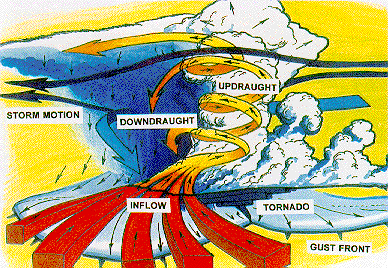

Thunderstorms, an intense weather phenomenon that is beautiful, powerful, and dangerous. Each thunderstorm contains clouds which create their own winds, and atmosphere. The thunderstorm packs as much energy in it to equal the atomic bomb. It is also the reason behind TORNADOES which are huge vacuums for the thunderstorm to feed itself. I will try to explain the thunderstorm in as simple terms as possible and explain further as needed.
First, let me exp[lain a little about the clouds of a thunderstorm. The clouds of a thunderstorm are called CUMULONIMBUS clouds as explained in the clouds page. These clouds are the furnaces of the storm in that they take in the energy and make the storm cell grow. The cell is the term for the main part of the cloud where the heights reach the highest in the atmosphere. Within the cloud structure, updrafts are created which draws in more moisture. As the tops of the clouds grow to above 39,000 feet (or sometimes lower), the mositure in the cloud freezes as the temperatures of that height are usually well below freezing. Hail is the result.
 As moisture within the cloud
is drawn upward from the updrafts, and the begin to freeze in the cloud
tops, hail is formed. The hail falls lower in the cloud and if the updrafts
are strong enough, and the temperatures are cold enough within the cloud,
it will be drawn back up by the updrafts, take on more moisture and grow,
and it can repeat this falling, lift back over and over until it is finally
too heavy for the winds. Hail can be pea- sized up to a couple of inche
in diameter. A Hailstone that is just 1/4- 1/2 inches in diameter can cause
dents in cars and break thin glass. Anything larger will cause more damage
including killing people.
As moisture within the cloud
is drawn upward from the updrafts, and the begin to freeze in the cloud
tops, hail is formed. The hail falls lower in the cloud and if the updrafts
are strong enough, and the temperatures are cold enough within the cloud,
it will be drawn back up by the updrafts, take on more moisture and grow,
and it can repeat this falling, lift back over and over until it is finally
too heavy for the winds. Hail can be pea- sized up to a couple of inche
in diameter. A Hailstone that is just 1/4- 1/2 inches in diameter can cause
dents in cars and break thin glass. Anything larger will cause more damage
including killing people.
Hailstones are also what scientists beleive cause of lightning. The constant coliding and rubbing of hailstones in a swirling motion creates a static elecrtic charge--similar to dragging your feet on a carpet and touch the doorknob, but on a larger scale. The charge it creates is a positive charge, and the ground is negatively charged. A natural attraction of opposites occurs in the form of lightning. This is how the cloud neutralizes itself by grounding itself out electrically.
 Lightning is, as I said, a static discharge, but much more powerful than
what you get when you touch your car or the doorknob. It is a charge containing
over 20,000 volts and up to a million amperes! It only takes 1/2-1 ampere
to kill a human, so you can see the danger in it. The temperature is above
50,000 degrees farenheit--Hotter than the surface of the sun!! See:
Lightning facts to find out
other interesting facts about lightning.
Lightning is, as I said, a static discharge, but much more powerful than
what you get when you touch your car or the doorknob. It is a charge containing
over 20,000 volts and up to a million amperes! It only takes 1/2-1 ampere
to kill a human, so you can see the danger in it. The temperature is above
50,000 degrees farenheit--Hotter than the surface of the sun!! See:
Lightning facts to find out
other interesting facts about lightning.
So why does the thunder we hear come so long after the flash of lightning? To understand this, you have to understand sound waves and radio or light waves. A sound wave is a wave of sound as it goes through something like air, and it can only move so fast. GEE WIZ: The speed of sound is approximated at about 750 miles per hour. There is a certain speed at which speed can travel and if you know about radio waves, or light waves, you know that they travel faster. GEE WIZ: Light speed is approximately 186,000 miles per SECOND. Therefore, light travels much faster than sound and this is why we see the lightning before we hear the thunder.
A thunderstorm can pack winds up to 210 MPH if it is located within a HURRICANE. But for an average thunderstorm, they can still reach speeds of 100 MPH and can damage trees, roofs etc. The lightning in a thunderstorm kills about 2000 people a year in the United States, but you still need to stay aware of it. Hail is another problem to watch for since it is a ball of ice that can get as large as 3 inches in diameter! Can you imagine getting hit by a ball of ice falling from the sky at about 118 MPH that is 3 inches in diameter? GEE WIZ: The critical speed at which something falls is about 118 MPH.
For further information about thunderstorms, you can visit The Weather Channel. or
NCSA's
information on thunderstorms.